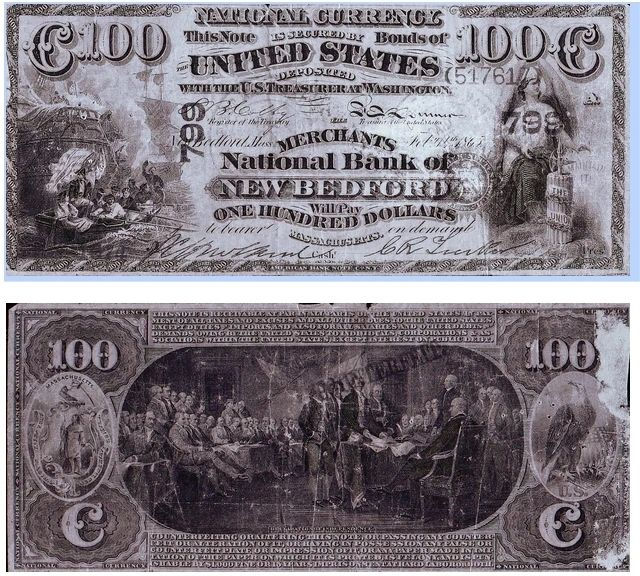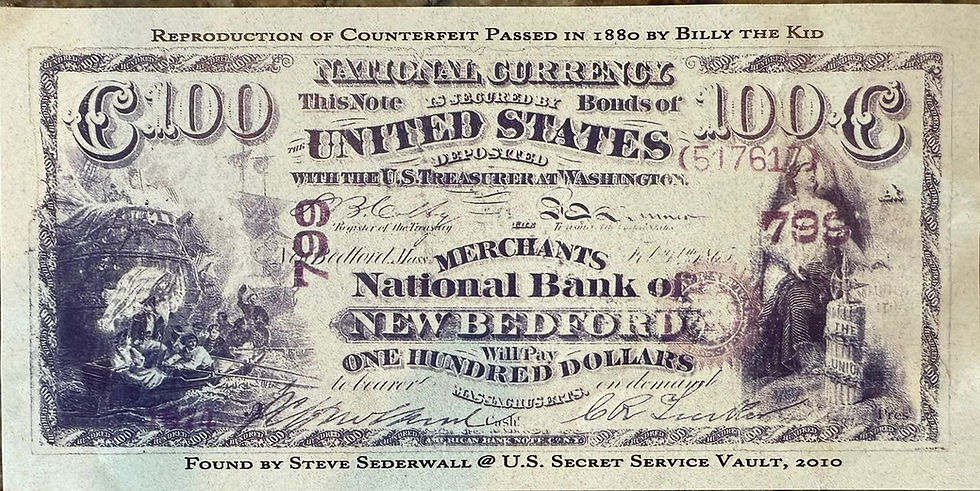Billy’s Bill or Just Bull? Unraveling Counterfeit Controversy
- jeremiahslatten
- Apr 13
- 5 min read
Updated: Sep 24
This serves as a retraction and correction of the article "A Brief Bit of History from the Cold West Files," by Steve Sederwall, which appeared in Volume 3 of our Coalition Press. When we support wrong history, and are shown the errors, we regard it our duty to correct ourselves and realign our trajectory with the facts. We have reached out to Steve Sederwall and David Turk for their conment, but as of this posting, have received no response.

On December 31, 2022, Sederwall advised his audience in his Cold West Detective
Agency Facebook group that he was thinking of writing a book, and shared the first five paragraphs with his fans. While not revealing anything groundbreaking.Sederwall does share some pretty good images of the counterfeit note marked 517617, without handwriting from Wild,and without Dolan's "D."
In July of 2010, the El Paso Times ran an article by Julie Carter entitled “Counterfeit Bank Note Rewrites Chapter of Billy the Kid.” The article opens with the claim that “one of the counterfeit bank notes proven to be in the sequence passed by Billy the Kid and his gang has found its way back to Lincoln County.”
The two men responsible for this counterfeit bill “finding its way” back to Lincoln were Steve Sederwall and (at that time) historian for the U.S. Marshals, David Turk.
Sederwall was already well known for the notorious dust-up of 2003-2004, involving DNA testing of floorboards and furniture, digging up bullet shells, and exhumation attempts of Billy the Kid and his mother (and one successful exhumation of Billy the Kid claimant John Miller – and the occupant of the grave next to him).
According to the article, in January of 2010, Steve Sederwall called up the Secret Service, and got a hold of Michael Sampson, often referred to as an archivist in the Secret Service division.
Knowing that Secret Service Agent Azariah Wild examined the counterfeit note that Billy Wilson passed to James Dolan, and that its serial number was 517607, Sampson searched some files.
Although none of the men seemed to expect any real results, Sampson (according to the article) called Sederwall back the next day, saying he had found a counterfeit note, serial number 517617.
The fact that the serial number of this newly discovered note was one digit off from the note reported by Agent Wild in 1880 was no deterrent to Sederwall. He simply came up with a reason for the discrepancy: “the second number from the right had been changed from a zero to a one.”
The only issue is, anyone examining the note in question with two functioning eyes - perhaps even one moderately functioning eye - can see that the “1” in the serial number has not been altered at all. There is no trace of a phantom “0,” no evidence of tampering. And why would there be? Was there a counterfeit-counterfeiting ring going around at the same time in New Mexico, altering counterfeit notes by changing already fake serial numbers, in order to make them appear more counterfeit to fool the counterfeiters?
Clearly, the note found by Sampson is a counterfeit note from the New Bedford bank plates, just like the note passed by Wilson to Dolan. It may have been part of the same batch as the ones that made their way to New Mexico, including the one marked 517607.
But contrary to Sederwall’s claims, the note re-discovered in 2010 is not the same note.
The discrepancy in serial numbers is not the only witness against this claim.
We have the testimony of Secret Service Operative Azariah Wild himself.
On October 5th, 1880, Wild reports that the $100 counterfeit note on the Merchant’s National Bank of New Bedford, serial number 517607, upon its being received, was marked by Jimmy Dolan with the letter “D.” An examination of Sederwall’s $100 bill reveals that there is, in fact, no marking of a “D” anywhere on the bill, front or back.
For further proof of Sederwall’s bill being misidentified, researchers can visit Wild’s daily report to his chief, dated October 2, 1880, where he states that, “after looking at the note, and taking a description of the same, I wrote my name in full across the face with the date of October 2nd 1880 underneath it.”
If Sederwall is granted the possibility that there is a magical disappearing ink mechanism that can manage the vanishing of a handwritten “D” in nineteenth century ink without a trace of detection, as well as the flawless alteration of a serial number with no trace of tampering, the ability of any such piece of technology to erase a Secret Service agent’s enormous signature across the face of the bill, as well as an equally largely printed date beneath it, must be stretch the credulity of even the greenest novice out there.
An examination of the counterfeit note Sederwall peddles as Billy Wilson’s “Dolan note” will show that there was never any handwriting on it, either from Dolan or Wild, just as there was never any alteration of its serial number. It could very well be a counterfeit note from the same or similar batch, but is not the specific piece of history they are claiming it to be.
Sederwall must not have been satisfied with Ms. Carter’s article of July 2010. Or maybe he just needed another dose of spotlight when he wrote “Billy Bonney’s Bad Bucks” for True West Magazine on April 28, 2015.
In an effort to razzle-dazzle and next-level this counterfeiting business, Sederwall introduces in this article Jesse James, John Hays, William Brockway, Missouri Civil War connections, the underbelly of New York organized crime, and much more.
In Sederwall’s article, Agent Wild catches Dolan by surprise, with counterfeit notes in Dolan’s safe, and Dolan shifts the blame on Billy Wilson. (It was actually Mr. Larue who owned the store in which the bill was passed; Dolan was just a clerk. Dolan was introduced to Wild by Ira Leonard, and the counterfeit bills in the safe at the Larue store had already been noted and reported.)
One final piece of this tale involves the perspective of Michael Sampson, the Secret Service public affairs contact who tracked down the counterfeit note for Sederwall. Does his version of events match Sederwall’s? Did he call them back, ecstatic, that a heretofore unidentified counterfeit note in the “vault” had now been identified as one of “Billy Bonney’s bad bucks?”
In “The Billy the Kid’s Bad Bucks Hoax,” author Gale Cooper tells readers that she was able to reach Michael Sampson, and “he told me what actually happened.” According to Cooper, Sederwall contacted Sampson in 2010 asking for counterfeit bills involved in the Azariah Wild case in New Mexico. “Sampson told him there were none in the files.
So Sederwall requested any counterfeit bill from the period. It had no documented
connection…to Wild or to Billy Bonney; and it was not filed as a Brockway bill.”
That really sums up the whole situation. This counterfeit note claim by Sederwall is just another public relations spotlight-grab. He misrepresented the serial number. He misrepresented (according to Cooper) their communications with the Secret Service, and, once again, he misrepresented history.




Comments